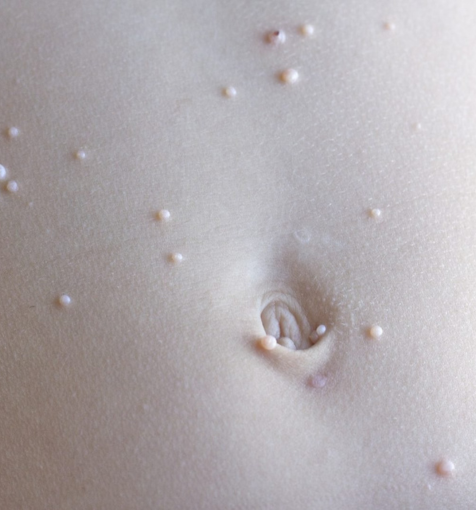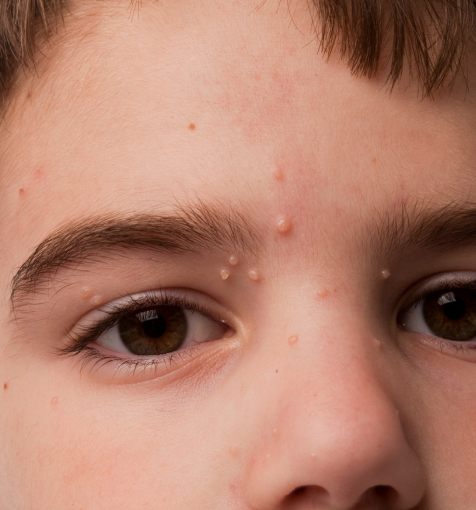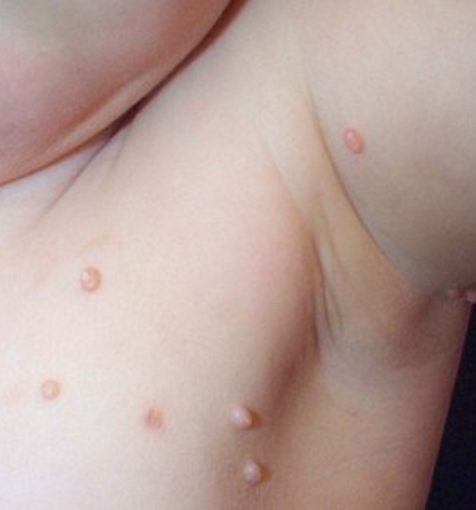Clear and Effective Molluscum Treatment in New Jersey
Molluscum contagiosum is a common viral skin condition that causes small, dome-shaped bumps to appear on the skin. While it is generally harmless, it is contagious and can spread through direct contact or by sharing personal items such as towels or clothing. Children are the most frequently affected, but adults—especially athletes in close-contact sports like wrestling and gymnastics—can also develop molluscum. At Skin & Laser Center of NJ, we provide safe and effective treatments designed to clear lesions, prevent spread, and restore healthy, smooth skin.


Molluscum contagiosum is caused by a poxvirus that enters the skin through minor cuts or abrasions. After exposure, it can take several weeks before bumps appear. These growths are typically small, pink or flesh-colored, and may have a dimpled center. Most patients develop 10 to 20 bumps, though the number can vary.
The condition is contagious, spreading easily from person to person or even to other areas of the same individual’s body. While the bumps are not usually painful, they may cause itching, redness, or irritation. Without treatment, molluscum can persist for months or even years, and new bumps may continue to form over time.
Although molluscum may eventually resolve on its own, professional treatment offers several important benefits, including:
Shortening the course of the infection
Preventing the spread to other parts of the body or other people
Reducing irritation and secondary skin infections
Improving cosmetic appearance and patient comfort
Treatment is especially important for patients with weakened immune systems, widespread lesions, or lesions in sensitive areas such as the face, genitals, or around the eyes. Parents often choose treatment for their children to help stop the cycle of spreading molluscum among siblings or classmates.


Our dermatologists provide a variety of effective options for removing molluscum lesions in a safe, controlled manner. Depending on the patient’s age, medical history, and severity of the condition, treatment may include:
Cryotherapy – freezing lesions with liquid nitrogen
Curettage – gently scraping away the bumps
Topical therapies – applied medications that target viral growth
Laser treatments – precision removal with minimal damage to surrounding skin
These treatments are quick, minimally invasive, and designed to minimize scarring or discomfort. By tailoring each plan to the individual, we ensure the best possible results and long-term skin health.
Learn More About Molluscum
Patients experiencing a molluscum contagiosum outbreak typically experience some variation of the following symptoms:
Note that the bumps are usually painless, but some bumps itch, especially if you develop a rash around them. Lesions may also turn red as the immune system fights the virus, which is when you can develop an itchy rash.
Patients experiencing a molluscum contagiosum outbreak typically experience some variation of the following symptoms:
Note that the bumps are usually painless, but some bumps itch, especially if you develop a rash around them. Lesions may also turn red as the immune system fights the virus, which is when you can develop an itchy rash.
Molluscum bumps typically form in clusters. Other common skin growths include red-pigmented cherry angiomas and darker-tinted moles. Contact the Skin & Laser Center of NJ to get an accurate diagnosis and the appropriate treatment for any unusual bumps or lesions that develop.
Convenient walk in hours available below. No appointment needed! Accepting private insurance and medicare. No medicaid plans.
Learn more about medical treatments at New Jersey’s Skin & Laser Center of NJ. Call 201-500-7525 or contact us online to schedule a consultation.